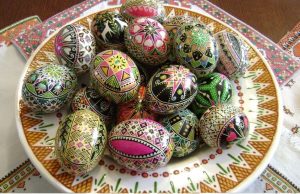 Christine Levy hunches over a white chicken egg. She sticks a quill in the flame of a candle to heat it then pokes the quill into a chunk of beeswax. As the smell of beeswax fills the air, she begins to write. Christine has been practicing her craft of Pysanka (traditional Ukrainian egg decorating) for more than 50 years. As a 2nd generation Ukranian, she learned her craft as a child, handed down through the generations. Her grandparents kept up with the traditions of the culture, especially dying and decorating eggs. “It‘s a clever folk art because it doesn’t take much to do it: beeswax, candle and dye,” she says. Christine begins with chicken eggs from local farms. Farm-bought eggs are better than store-bought because “they are stronger and take the dye better.” She uses a white egg that has not been hollowed out: a hollow shell is very porous and does not take dye as well as a full egg. Then she writes on the egg with beeswax. (The word pysanka comes from the verb pysaty, “to write,” as the designs are not painted on, but written with beeswax.)
Christine Levy hunches over a white chicken egg. She sticks a quill in the flame of a candle to heat it then pokes the quill into a chunk of beeswax. As the smell of beeswax fills the air, she begins to write. Christine has been practicing her craft of Pysanka (traditional Ukrainian egg decorating) for more than 50 years. As a 2nd generation Ukranian, she learned her craft as a child, handed down through the generations. Her grandparents kept up with the traditions of the culture, especially dying and decorating eggs. “It‘s a clever folk art because it doesn’t take much to do it: beeswax, candle and dye,” she says. Christine begins with chicken eggs from local farms. Farm-bought eggs are better than store-bought because “they are stronger and take the dye better.” She uses a white egg that has not been hollowed out: a hollow shell is very porous and does not take dye as well as a full egg. Then she writes on the egg with beeswax. (The word pysanka comes from the verb pysaty, “to write,” as the designs are not painted on, but written with beeswax.)
“Wherever you put the beeswax you are masking the color,” she says. “So I start with white then stick the egg in a light dye color like yellow.” She continues to write and mask more areas that she wants to keep yellow, then she dunks the egg into another dye color, working from light to dark. She keeps working until “[the egg] is black and covered with beeswax.” She removes the wax by sticking it in a toaster oven, though her ancestors would have held the egg over a flame to slowly melt off the wax.
Even after 50 years of creating, she still is enchanted and surprised when she removes the wax to see her creation. “You don’t know what it is going to look like. Every egg is different and takes dyes differently,” she says. When finished, Christine adds a coat of Polyurethene to make them shiny and also a bit stronger.
At this time of year, her decorated eggs can be used as ornaments on Christmas trees but they originated as an Easter tradition that is still alive and well in the Ukranian community. In her cultural tradition, one would make an egg as a gift where the pictures painted tell a story. Christine uses images like horses, which represent health and strength, and ribbons, which represent eternity and wisdom, on her eggs. “Deer and horses are my favorite images as well as flowers. It’s like handwriting – everyone has their unique handwriting and it’s the same for egg painting,” she says.
Ukranians also take pride in their ceramic work. “Many homes have a stove in the center completely lined with handmade tiles,” she says. Christine paints ceramics – porcelain and China – and has a lovely collection of pocket mirrors as well as small plates in the Market. To make the pocket mirror, she makes a pencil sketch then scans and prints it on thin plastic polymer. She fuses it to porcelain, like the back of the hand mirror, then decorates it with enamel paints. She fires it in an oven, not a kiln, until everything fuses to the porcelain.
“I love experimenting,” she says. “Every couple of years I feel like I am in a new zone. I just discovered last year how to get a really nice light green. I have been doing this for 50 years and I just figured it out. There’s also always something to learn.” Thankfully, Christine also teaches how to make her stunning eggs. “I love teaching because I don’t want to take all this knowledge with me.” Her ancestors would be proud.
